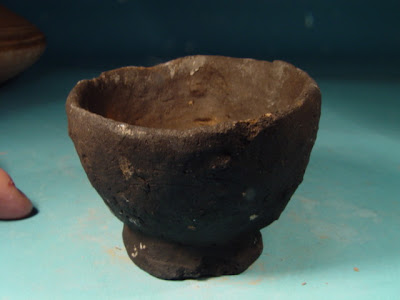The no-questions-asked antiquities trade is a frustrating place, on the one hand one's blood boils when we see archaeological artefacts obviously freshly ripped from their contexts on sale to anybody who is not too concerned about the damage caused and selfish enough to want to buy them. On the other one's blood boils when faced with some pretty bare-faced cheatery and total ignorance among sellers and buyers.
 I'm not sure which of the latter two categories to place this one. A British seller has an item on sale in his online gallery, he calls it a "European Pre Celtic Bronze Age Hand Made Pot 600 BC!". Now "pre-Celtic" is an interesting concept, sort of makes the primitive wonky pot on sale sound primevally attractive. I also had words in the past with this seller about some central European pot he was selling as "Bronze Age" which was Iron Age (or was it the other way around?), so "pre-Celtic" could be fluff term to avoid being specific.
I'm not sure which of the latter two categories to place this one. A British seller has an item on sale in his online gallery, he calls it a "European Pre Celtic Bronze Age Hand Made Pot 600 BC!". Now "pre-Celtic" is an interesting concept, sort of makes the primitive wonky pot on sale sound primevally attractive. I also had words in the past with this seller about some central European pot he was selling as "Bronze Age" which was Iron Age (or was it the other way around?), so "pre-Celtic" could be fluff term to avoid being specific.The sales spiel is wonderful, conjuring up a vision of primeval forests and the noble savage struggling to control the environment. In the work on artefact hunting which I wrote with Nigel Swift we call this "narrativisation" and its an important part of collecting, but also marketing the goods.
So where does it come from? It was, the seller assures us "found in Germany near the Danube river", so that's anywhere along a 400-km long line... It also apparently was "Formerly in the collection of an English gentleman". Well, how could it be otherwise? (Are all collectors automatically "gentlemen"?)
The seller assures customers that his firm "employs a number of experienced consultants who specialize in authenticating ancient art to offer you the necessary protection". I think we all should know the name of the experienced consultant that authenticated the object shown in the photos as a "very rare, late bronze age Cremation pot or cooking pot", as it is clear they know next to nothing about Late Bronze Age pottery of central Europe.


The photograph shows a handmade vessel, yes. The vessel has clearly been bonfire-kiln fired, yes (it still has the ash on it). The form however is an imitation of a teacup on a raised footring. The fabric of this piece is nothing like that of ancient ceramics of the period and region suggested as its origin before it got to the "gentleman's collection". I challenge the seller and the consultant to show us a similar form vessel from an excavated Late Bronze Age settlement or cemetery with the same surface finish and fabric.
Any archaeologist who has handled any ancient pottery from central Europe will be able to see that this is a modern piece, it still has the ash on it, and clearly has never been buried in the ground, probably this was produced as "experimental archaeology" (maybe during an excavation as many archaeologists have had the opportunity to partake in). As such there is no reason why it cannot be collected, but it should not be being sold as an authentic Late Bronze Age artefact. With three days to go, seven people are bidding on this.
The seller is a well-known antiquities dealer from Cambridge and a frequent contributor to artefact discussion forums. He also has a large number of objects on sale which in one way or another I would categorise as "dodgy", misdescription being just one of the problems.
There is an awful lot wrong with the no-questions-asked antiquities trade in Britain and elsewhere, while dealers are unaccountable for the proper description of what they sell, and there is a total lack of transparency, they can get away with a great deal, like selling illicitly-obtained items, or outright fakes.
Photo: Eftis Paraskevaides' "Bronze Age teacup". Although he says the images on eBay are his "copyright" I'm putting them up here as a public service, and if he wishes to challenge it we can discuss how he ascertained that the object(s) he bought from the gentleman as antiquities left Germany legally, has he seen an export licence for this? Otherwise he could be culpable under the 2003 Dealing in Cultural Property (Offences) Act. Not of course if he knew it was a fake when he bought it, but then why is he selling it as something else?








.jpg)


2 comments:
Is a better name the "caveat emptor" antiquities trade? Unbelievable...
Well, sadly there is an awful lot of junk archaeology out there, and an awful lot of gullible antiquity collectors with little to no knowledge of what they are looking at and money to throw away on it...
Post a Comment